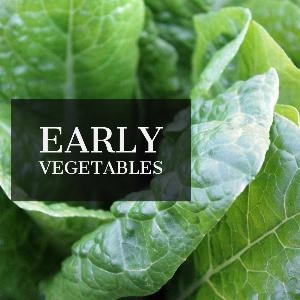Many vegetables have best flavor and production when they are grown in cool weather. Spinach is one of these. Once up, thin spinach to every four to six inches so it won’t go to seed so quickly. Mulch it, too, to keep the soil moist and keep weeds down, because weeding can damage the roots. Plant spinach every ten days until hot weather for a continuous harvest. Chard is another wonderful green with huge leaves, but it doesn’t require successive plantings as it will replace the leaves you pick. Plant a few feet of lettuce every two to three weeks for a constant supply. Plant these leafy green crops where the root crops were planted last year, and plant root crops where peppers or tomatoes grew last year. This will keep your production high and protect against disease. Carrots and turnips are very slow to germinate, taking up to twenty days to come up, so plant a row of radishes, which come up in five to ten days, right next to them as a row marker. As soon as the carrots or turnips are up four or five inches, put a layer of mulch around them to keep them moist and to cover the crowns so they won’t become green and bitter. Parsnips can be planted early and like deep, loose soil. Soaking the seeds before you plant them helps them come up faster, but they are also very slow, so mark them with radishes, too. Cauliflower can be set out two weeks before the last frost, but be sure to mulch around it to keep the soil moist. If Cauliflower gets dry, the heads won’t be firm. Cabbage and Brussels Sprouts can be set out four weeks before the last frost date. Onions and peas, along with beets, are more favorite early planters. Plant plenty of peas, as peas actually improve the soil and other crops will flourish next year where the peas were planted. When the peas are done producing, till the green plants in to give your soil a real boost. Don’t plant beans and corn too early, though, as doing so, especially in wet, cold weather, may cause the seed to rot, or, the seedlings may be killed by frost. Don’t forget you can use a garden weed preventer on these early crops to keep them weed free all season.




